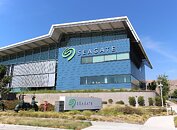- Joined
- Oct 9, 2007
- Messages
- 47,449 (7.50/day)
- Location
- Hyderabad, India
| System Name | RBMK-1000 |
|---|---|
| Processor | AMD Ryzen 7 5700G |
| Motherboard | ASUS ROG Strix B450-E Gaming |
| Cooling | DeepCool Gammax L240 V2 |
| Memory | 2x 8GB G.Skill Sniper X |
| Video Card(s) | Palit GeForce RTX 2080 SUPER GameRock |
| Storage | Western Digital Black NVMe 512GB |
| Display(s) | BenQ 1440p 60 Hz 27-inch |
| Case | Corsair Carbide 100R |
| Audio Device(s) | ASUS SupremeFX S1220A |
| Power Supply | Cooler Master MWE Gold 650W |
| Mouse | ASUS ROG Strix Impact |
| Keyboard | Gamdias Hermes E2 |
| Software | Windows 11 Pro |
Seagate Technology Holdings plc, a world leader in mass-data storage infrastructure solutions, and Phison Electronics Corp., a global leader in NAND flash controller and storage solutions, announced today plans to expand their SSD portfolio of next-gen high-performance, high-density enterprise NVMe SSDs. The new SSDs will help enterprises lower total cost ownership (TCO) through increased storage density, lower power consumption, and higher performance. The companies also announced that they have entered a long-term partnership that will strengthen the development cycle and distribution of enterprise-class SSDs.
Seagate and Phison have collaborated on Seagate's mainstream SATA SSD products since 2017. That close cooperation has continued through the company's performance-leading line of FireCuda consumer gaming NVMe PCIe Gen4 x4 SSDs and the world's first purpose-built NAS NVMe SSDs. The partnership will now focus on meeting the evolving global enterprise demand for higher density, faster, and smarter storage infrastructure needs that complement HDD storage to enable comprehensive enterprise applications such as hyperscale data center, high-performance computing and AI.

"We integrated Seagate's 40-plus years of market-leading enterprise storage expertise with Phison's nimble ability to create highly customized SSDs to meet the ever-evolving needs of the enterprise storage market," said Jeff Fochtman, senior vice president of business and marketing at Seagate Technology. "Seagate is extremely excited to work with Phison on developing advanced SSD technology. Our selective focus allows us to serve the broad performance-driven enterprise SSD market while continuing our leadership in the specialized premium gaming SSD segment."
"Phison is proud to partner with Seagate to expand our enterprise SSD product line," said Sebastien Jean, CTO of Phison Electronics. "Our leading in-house ASIC technology, coupled with engineering excellence, complements Seagate's deep industry knowledge. In a show of commitment to this partnership, in 2020 we opened a development center in Broomfield, Colorado. Together, we will deliver winning solutions for a wide range of applications including Artificial Intelligence, Cloud Storage, and 5G edge computing."
Seagate and Phison will work together to strengthen the industry's enterprise-class SSD product offerings focusing on best-in-class performance, cost savings, and efficiency. Optimized for specific workloads, environments, and use cases, each new product will be engineered and customized to specifically address a customer's technical needs.
Detailed product announcements from this partnership will be shared in the summer of 2022.
View at TechPowerUp Main Site
Seagate and Phison have collaborated on Seagate's mainstream SATA SSD products since 2017. That close cooperation has continued through the company's performance-leading line of FireCuda consumer gaming NVMe PCIe Gen4 x4 SSDs and the world's first purpose-built NAS NVMe SSDs. The partnership will now focus on meeting the evolving global enterprise demand for higher density, faster, and smarter storage infrastructure needs that complement HDD storage to enable comprehensive enterprise applications such as hyperscale data center, high-performance computing and AI.

"We integrated Seagate's 40-plus years of market-leading enterprise storage expertise with Phison's nimble ability to create highly customized SSDs to meet the ever-evolving needs of the enterprise storage market," said Jeff Fochtman, senior vice president of business and marketing at Seagate Technology. "Seagate is extremely excited to work with Phison on developing advanced SSD technology. Our selective focus allows us to serve the broad performance-driven enterprise SSD market while continuing our leadership in the specialized premium gaming SSD segment."
"Phison is proud to partner with Seagate to expand our enterprise SSD product line," said Sebastien Jean, CTO of Phison Electronics. "Our leading in-house ASIC technology, coupled with engineering excellence, complements Seagate's deep industry knowledge. In a show of commitment to this partnership, in 2020 we opened a development center in Broomfield, Colorado. Together, we will deliver winning solutions for a wide range of applications including Artificial Intelligence, Cloud Storage, and 5G edge computing."
Seagate and Phison will work together to strengthen the industry's enterprise-class SSD product offerings focusing on best-in-class performance, cost savings, and efficiency. Optimized for specific workloads, environments, and use cases, each new product will be engineered and customized to specifically address a customer's technical needs.
Detailed product announcements from this partnership will be shared in the summer of 2022.
View at TechPowerUp Main Site


